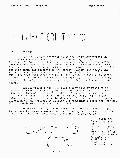 Astronautical Biophysics
Astronautical Biophysics
Andy Young
Part I. Theory
One of the more interesting of the early experiments in biophysics was the relating to the sense of equilibrium in the lobster. Various of the Crustacea possess a balancing organ which consists of a cavity in the side of the head, lined with fine hair-like projections. These animals shed their exoskeletons periodically, and with them, the contents of the cavity. After each moult, the animal is unable to retain its balance for a short time. It was suspected that just after the moult, the lobster places a few grains of sand in the cavity; the direction of gravity is then detected by means of the weight of the sand grains, which press downward on the hairs.
This hypothesis was brilliantly confirmed by means of an experiment in which a freshly-moulted lobster was placed in a bare aquarium. Instead of sand, the bottom of the aquarium was covered with iron filings. The animal placed the iron filings in its balancing organ, and the experimenter was able to reverse the apparent direction of the vertical by holding a strong magnet above the lobster, which immediately turned over on its back.
In order to study the effects of a variable apparent direction of gravity on an organism more similar to Man, it was decided to perform an analogous experiment with a cat. (See Fig. 1)
Since the balancing organ of the cat is not similar to the balancing organ of the lobster, the proceedure had tobe modified somewhat; however the basic idea remains the same. By introducing magnetic material into the balancing organ of the cat, it was hoped that the effect of a variable gravatational field might be simulated.
Part II. Experimental Technique
A standard laboratory cat, Felis scientifica, was tested for scuity of balance. It was found that in a series of ten trials in which the cat was dropped from randomly chosen positions, and through heights ranging from one foot to five feet, the cat never failed to strike the substratum in a normal (i.e., erect) position. It was judged that the cat's sense of balance would be sufficiently accurate for the purposes of the experiment.
A suspension of precipitated magnetic iron oxide was then prepared. The diameters of the suspended particles were uniform enough to be measured by means of Young's eriometer; the mean diameter was 12 microns. The suspension contained 1.142 milligram of suspensoid per millimeter.
The cat was anaesthetized and its inner ears were exposed. Approximately five cubic millimeters of suspension was added to the fluids of the semicircular canals of each ear with a micropipette, and the cat's ears were otherwide returned to their normal condition.
When the cat had recovered from the operation, its normal balancing sense was again tested, as before, and (within the limits of experimental error) found to be the same as before. (See Fig. 2.)
Next, the cat was placed nine feet away from a large electromagnet of the parallel-pole, research type, capable of producing a uniform field of 9500 gauss over an area of 125 cm2. As the magnetizing current was increased, the cat was observed to tilt gradually toward the magnet. The observations are summarized in Table 1.
Table 1.
| Pole separation: 5 cm. | |
| Intensity of field in air gap | Angle of tilt of cat |
| (gauss) | (degrees) |
| 1000 | 0.1? |
| 2000 | 0.25 |
| 3000 | 0.40 |
| 5000 | 0.55 |
| 8000 | 0.95 |
| 9500 | 1.15 |
The uncetainty in the angle of tilt is of the order of the tilt itself, for the lower values, but it appears that the tilt is a linear function of the magnetic field. The experiment was repeated, placing the cat only one foot from the magnet. The results are summarized in Table 2.
Table 2.
| | |
| Intensity | Tilt |
| | |
| 1000 | 4.0 |
| 2000 | 7.9 |
| 3000 | 11.9 |
| 5000 | 20.0 |
| 8000 | 28.5 |
| 9500 | 39.8 |
It appears that a larger magnet is needed to completely overcome the effects of gravity. A larger magnet was obtained with a pole separation of 10 cm. and field strength of 16,000 gauss. This was found to be more than adequate. At a distance of two feet and the field strength of 12,000 gauss, the inclination of the cat was 75o.
The larger magnet was then placed above the cat's cage and the field strength gradually increased until the cat experienced no net apparent gravatational force. At this point the cat appeared to become confused. Finally, the magnetic field was increased to full strength, so that the cat experienced a net upward field. By this means the cat was made to walk about on the roof of its cage. (See Fig. 4)
PART III. Conclusions.
We conclude that magnetic cat tipping is highly practical and has the obvious advantage that the degree of tilt can be accurately controlled by varying the magnetic field. This should prove to be a valuable research tool in investigating the behavior of cats and other mammals under conditions of variable (apparent) gravatational fields.
----- A. Young
(illustrated by the author)
Data entry by Judy Bemis
Hard copy provided by Geri Sullivan
Data entry by Judy Bemis
Updated August 29, 2002. If you have a comment about these web pages please send a note to the Fanac Webmaster. Thank you.